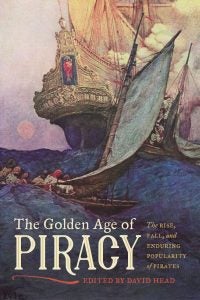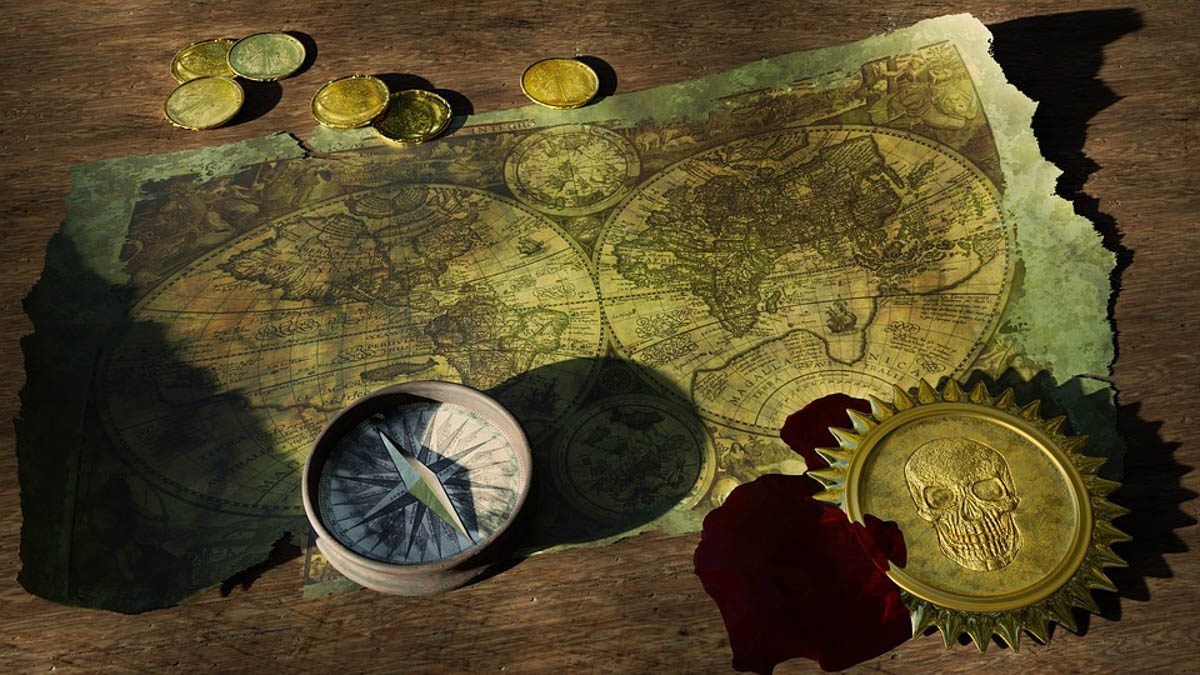David Head, a UCF history lecturer, says he can’t remember exactly when his affinity for pirates began — but it could have been when he was in the first grade and the Disney Channel showed the miniseries Return to Treasure Island, a child’s sequel to the classic story.
“I watched every Friday night with my older brother — 10 episodes in all,” Head said.
 Through the years, his interest in the high-seas robbers led him to study and write about the plunderers and how they thrived in the 17th and 18th centuries.
Through the years, his interest in the high-seas robbers led him to study and write about the plunderers and how they thrived in the 17th and 18th centuries.
Head, who teaches courses in American history and western civilization, came out with his latest book on the subject this year, an edited collection of essays, The Golden Age of Piracy: The Rise, Fall, and Enduring Popularity of Pirates (University of Georgia Press).
To help commemorate International Talk Like a Pirate Day, which is observed Sept. 19, we walked the plank with Head and asked about the scurvy rogues who wrote their own rules — but who today are often viewed as lovable characters.
Do you find that most people have a romantic fascination about pirates?
To me the really interesting thing is that the fascination goes back hundreds of years, at least to the 17th century, when plenty of real pirates sailed the seas. In (The Golden Age of Piracy), several essays address this question, with answers ranging from the propensity of English audiences to enjoy reading about their enemies, such as the Spanish getting plundered, or middle- and upper-class men living out fantasies of manly adventure through pirate stories. Today’s fascination with Talk Like A Pirate Day and pirate festivals has to have something to do with the popularity of Comic-Con and cosplay and adults dressing up like fictional characters.
Just how would you define a pirate?
Defining piracy is really hard. It’s one of the most debated parts of studying pirates. At it’s heart, piracy was robbery at sea; that is, the forcible taking of property from its lawful owner by people who know they have no right to the property. The problem is that a lot things that could be piracy don’t quite fit each of those elements. For example, privateers were vessels commissioned by a government during times of war to capture enemy property. They took goods by force like pirates, but they had a license to do so. Navies, too, captured property by force. So taking by force alone wasn’t piracy.
How would you describe the golden age of piracy? And when was it?
Historians differ in the application of the term, but I think of the golden age of piracy as describing the major waves of piracy associated with the Caribbean in the 17th and early 18th centuries. These are the pirates that most people think of as pirates — the pirates of Treasure Island and Pirates of the Caribbean. The idea of a golden age of piracy is as much about the legends of piracy as it is about the reality of pirate life, so I like how that description encompasses both sides.
How did they become so prominent and what led to their decline?
A combination of geopolitical factors came together in the 17th century to make piracy widespread in the Caribbean, and as the geopolitics changed over time, piracy also changed. A big part of the story was the fact that Spain claimed virtually all of the Americas — from Canada to Chile — as a result of Columbus’ discoveries. Spain defined all non-Spanish vessels anywhere in the Americas, sailing for any purpose, as pirates. The vessels could be captured and their crews executed. Spain’s rivals denied its claim to exclusive ownership of such vast territory and tried to fight their way in.
 England, France and the Netherlands all sponsored raids, some more official than others, to challenge Spain’s dominance. Henry Morgan — of rum fame — was an example of an English raider who operated with the blessing of the Jamaican governor. At the end of the 17th century, Spain was forced to recognize the legitimacy of its rivals’ colonies and the era of raiding as statecraft ended.
England, France and the Netherlands all sponsored raids, some more official than others, to challenge Spain’s dominance. Henry Morgan — of rum fame — was an example of an English raider who operated with the blessing of the Jamaican governor. At the end of the 17th century, Spain was forced to recognize the legitimacy of its rivals’ colonies and the era of raiding as statecraft ended.
In the early 18th century, piracy revived following the wreck of a Spanish treasure fleet off the Atlantic coast of Florida. Pirates preyed on the salvage operations and then organized themselves in the Bahamas. These are the notorious pirates like Blackbeard, who sailed in defiance of all authority and plundered the ships of every nation.
Piracy declined in response to changes in geopolitics, as seen with the buccaneers. Another major factor was changes in the support pirates received from communities ashore. Landlubbers supported piracy for many reasons, including the simple fact that they provided goods unavailable in the colonies by legitimate means. When pirates lost that connection, they lost the shelter they needed in between cruises.
Is there any one certain pirate most closely related to Florida?
I wouldn’t say there’s a particular Florida pirate. Sorry, Gasparilla fans: He’s a legend. But Florida’s Treasure Coast was a prime area for hunting ships. Because of the Caribbean’s geography and the way the winds and currents worked, the best way back to Europe from the Caribbean was sailing north through the Florida Straits between Florida and the Bahamas. It was easy to sit at the top of the strait and wait for a ship to come in sight.
Would pirates ever have come ashore?
Yes, their ships needed constant maintenance, just like every other kind of ship (ask a boat owner!). Pirates also depended on seaside communities to buy their stolen goods, and once they had money to spend, pirates partied like rock stars drinking, gambling, carousing until the money was gone. Generally, there’s no reason pirates would have gone too far inland, since they were mostly seafarers and most of the European populations in the colonial period were on the coast anyway.
Were there some gentleman pirates as we sometimes see portrayed in movies?
Stede Bonnet was an example of a gentleman who turned pirate. He was a planter on Barbados in the 1710s. Apparently bored of life on land, he heard the call of the sea, and became a pirate captain, though without much sailing experience, he didn’t last long. Pirates did, however, sometimes dress in flamboyant style as depicted in the movies — but not because of their personal flair. Clothes wear out fast at sea and rich cloths such as silks and muslins were some of the valuable cargoes they plundered. Some sailors were surprisingly skilled with needle and thread — which is not that surprising at all when you consider the need for sail repairs and all the time they had aboard ship with nothing to do. Put all that together and you can get an impressive wardrobe.
Is there still pirate treasure to be found?
I doubt it. Actually, there probably never was much pirate treasure. Pirates usually spent their loot as fast as they could, and then went out and robbed some more. They weren’t big on saving.
One of the best known legends of pirate treasure is told about Captain William Kidd, who raided in the Indian Ocean in the 1690s and was later arrested in Boston, and sent to London for trial. He was executed in 1701. He took a while sailing from the Indian Ocean back to North America, with stops in Madagascar, the Caribbean, and New York, where his family lived.
Meanwhile, authorities knew about his plundering, and the size of his haul grew with each telling. When he showed up in New York with far less, people concluded he must have hidden it somewhere. Back in 2015, an underwater archaeologist claimed to have found Kidd’s treasure in Madagascar. The government had a big ceremony showing off a bunch of supposed silver bars. Turns out, they were just lead.
Did Knights and Pirates coexist?
Yes, there were pirates in the Middle Ages when chivalrous knights jousted, but they were not the same pirates of the Caribbean, which Europeans had not yet encountered. Piracy was common in the Mediterranean and was often practiced by the Muslim states of north Africa, the Barbary pirates that the United States would fight against early in its history.
Did pirates keep monkeys and parrots as pets?
I haven’t seen it directly in the sources, but it’s entirely plausible. Pirates operated in the Caribbean and off the coast of South America and Africa where monkeys and parrots are common. Plus, in Europe at the time there was a market for exotic animals, so monkeys and parrots were valuable to pirates like anything else they captured. True, pirates would have preferred gold, but life aboard ship was really boring and animals could provide entertainment. So, why not?




